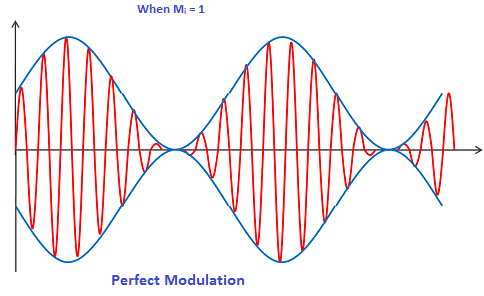
What is Perfect Modulation?
Answer
451.2k+ views
Hint:To avoid distortion in the modulated signal, the message signal's maximum amplitude must be smaller than (or equal to) the carrier signal's maximum amplitude. If the carrier signal has an amplitude of \[5\] volts, the message signal must have an amplitude of less than (or equal to) \[5\] volts. As a result, when \[Am{\text{ }} = {\text{ }}Ac\], the modulation index's maximum value will be less than or equal to one (\[Mi < = 1\]). The modulation index will have a minimum value of zero.
Based on this, there are \[3\] types of modulation:
Perfect-Modulation
Under-Modulation
Over-Modulation
Complete step-by-step solution:
Perfect modulation:
When the message signal or modulating signal, maximum amplitude is approximately equal to the carrier signal's maximum amplitude (\[Am{\text{ }} = {\text{ }}Ac\]), perfect-modulation occurs.
The modulation index is the ratio of the message signal's maximum amplitude to the carrier signal's maximum amplitude. For example, if the maximum amplitude of the message signal is \[4\] volts and the maximum amplitude of the carrier signal is also \[4\] volts, the modulating signal amplitude (\[4\] volts) to the carrier signal amplitude (\[4\] volts) ratio is\[1\]. As a result, with perfect-modulation, the modulation index is one (\[Mi{\text{ }} = {\text{ }}1\]).
The modulation depth is another name for the modulation index. The modulation depth of the perfect-modulation is\[100\% \]. The carrier level in perfect-modulation drops to $0$. There is no distortion with perfect modulation.

Note:Modulation benefits:
The size of the antenna was reduced.
There is no signal mixing.
The range of communication expands.
The transmissions multiplexed.
It is possible to change the bandwidth.
The quality of the reception improves.
Based on this, there are \[3\] types of modulation:
Perfect-Modulation
Under-Modulation
Over-Modulation
Complete step-by-step solution:
Perfect modulation:
When the message signal or modulating signal, maximum amplitude is approximately equal to the carrier signal's maximum amplitude (\[Am{\text{ }} = {\text{ }}Ac\]), perfect-modulation occurs.
The modulation index is the ratio of the message signal's maximum amplitude to the carrier signal's maximum amplitude. For example, if the maximum amplitude of the message signal is \[4\] volts and the maximum amplitude of the carrier signal is also \[4\] volts, the modulating signal amplitude (\[4\] volts) to the carrier signal amplitude (\[4\] volts) ratio is\[1\]. As a result, with perfect-modulation, the modulation index is one (\[Mi{\text{ }} = {\text{ }}1\]).
The modulation depth is another name for the modulation index. The modulation depth of the perfect-modulation is\[100\% \]. The carrier level in perfect-modulation drops to $0$. There is no distortion with perfect modulation.

Note:Modulation benefits:
The size of the antenna was reduced.
There is no signal mixing.
The range of communication expands.
The transmissions multiplexed.
It is possible to change the bandwidth.
The quality of the reception improves.
Recently Updated Pages
Master Class 12 Business Studies: Engaging Questions & Answers for Success

Master Class 12 Biology: Engaging Questions & Answers for Success

Master Class 12 Physics: Engaging Questions & Answers for Success

Class 12 Question and Answer - Your Ultimate Solutions Guide

Master Class 12 English: Engaging Questions & Answers for Success

Master Class 12 Economics: Engaging Questions & Answers for Success

Trending doubts
Which are the Top 10 Largest Countries of the World?

What is transplantation in agriculture class 12 biology CBSE

Differentiate between homogeneous and heterogeneous class 12 chemistry CBSE

Why is the cell called the structural and functional class 12 biology CBSE

Who discovered the cell and how class 12 biology CBSE

What is the Full Form of PVC, PET, HDPE, LDPE, PP and PS ?




